NVIDIA GeForce GTX 670 Review Feat. EVGA: Bringing GK104 Down To $400
by Ryan Smith on May 10, 2012 9:00 AM ESTOC: Power, Temperature, & Noise
Our final task is our look at GTX 670’s overclocking capabilities. Based on what we’ve seen thus far with GTX 670, it looks like NVIDIA is binning chips based on functional units rather than clockspeeds. As a result GTX 670 could have quite a bit of overclocking potential, albeit one still limited by the lack of voltage control.
| GeForce 600 Series Overclocking | |||||
| GTX 670 | EVGA GTX 670SC | GTX 680 | |||
| Shipping Core Clock | 915MHz | 967MHz | 1006MHz | ||
| Shipping Max Boost Clock | 1084MHz | 1188MHz | 1110MHz | ||
| Shipping Memory Clock | 6GHz | 6GHz | 6GHz | ||
| Shipping Max Boost Voltage | 1.175v | 1.162v | 1.175v | ||
| Overclock Core Clock | 1065MHz | 1042MHz | 1106MHz | ||
| Overclock Max Boost Clock | 1234MHz | 1263MHz | 1210MHz | ||
| Overclock Memory Clock | 6.9GHz | 6.6GHz | 6.5GHz | ||
| Overclock Max Boost Voltage | 1.175v | 1.162v | 1.175v | ||
Because of the wider gap between base clock and boost clock on the GTX 670 we see that it doesn’t overclock quite as far as GTX 680 from a base clock perspective, but from the perspective of the maximum boost clock we’ve slightly exceeded the GTX 680. Depending on where a game lands against NVIDIA’s power targets this can either mean that an overclocked GTX 670 is faster or slower than an overclocked GTX 680, but at the same time it means that overclocking potential is clearly there.
We’re also seeing another strong memory overclock out of a GK104 card here. GTX 680 only hit 6.5GHz while GTX 690 could hit 7GHz. GTX 670 is only a bit weaker at 6.9GHz, indicating that even with the relatively small PCB that NVIDIA can still exceed the high memory clocks they were shooting for. At the same time however this is a luck of the draw matter.
The EVGA card meanwhile fares both worse and better. Its gap between the base clock and and maximum boost clock is even larger than the reference GTX 670, leading to it having an even lower overclocked base clock but a higher overclocked maximum boost clock. The real limiting factor however is that it couldn’t reach a memory overclock quite as high as the reference GTX 670 – again, luck of the draw – which means it can’t match the overclocked reference GTX 670 as it’s going to be more memory bandwidth starved more often.
Moving on to our performance charts, we’re going to once again start with power, temperature, and noise, before moving on to gaming performance. We’ll be testing our GTX 670 cards at both stock clocks with the maximum power target of 122% (170W) to showcase what is possible at validated clockspeeds with a higher power cap, and a true overclock with a maximum power target along with the largest clock offsets we can achieve.
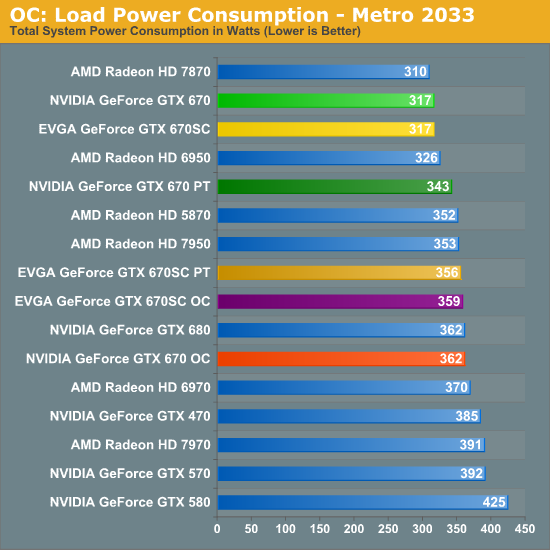
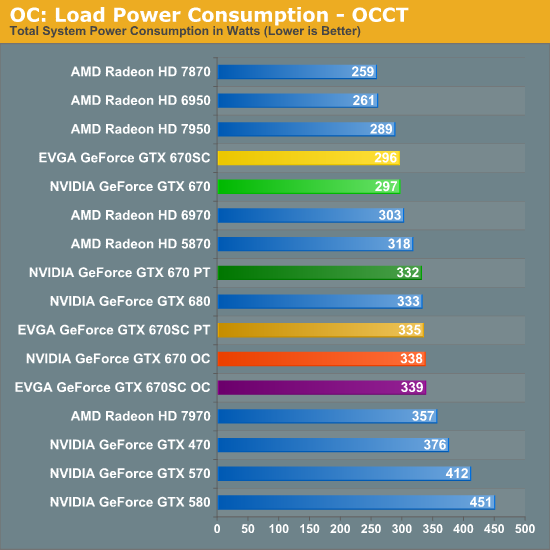
Not surprisingly, since we’re almost always operating within the realm of the power target as opposed to the TDP on the GTX 600 series, our power consumption closely follows our chosen power target. Cranking up the power target on the GTX 670 for example to 170W puts us within 6W of the GTX 680, which itself had a 170W power target in the first place. This is true for both Metro and OCCT, which means power consumption is very predictable when doing any kind of overclocking.
This also means that power consumption is still 18W-30W below the 7970, which in turn means that if these overclocks can close the performance gap, then the GTX 670 still has a power consumption advantage.
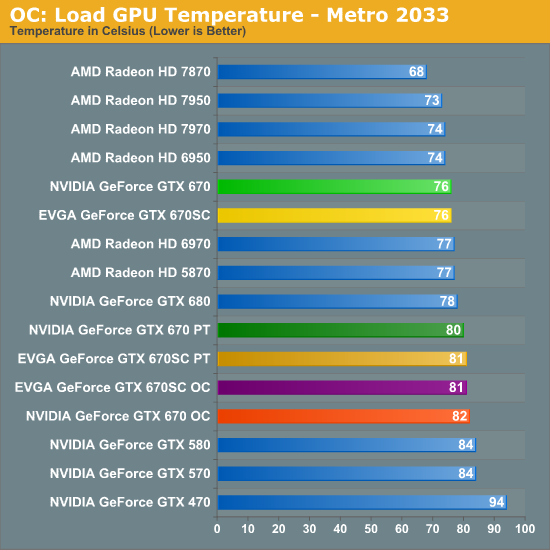
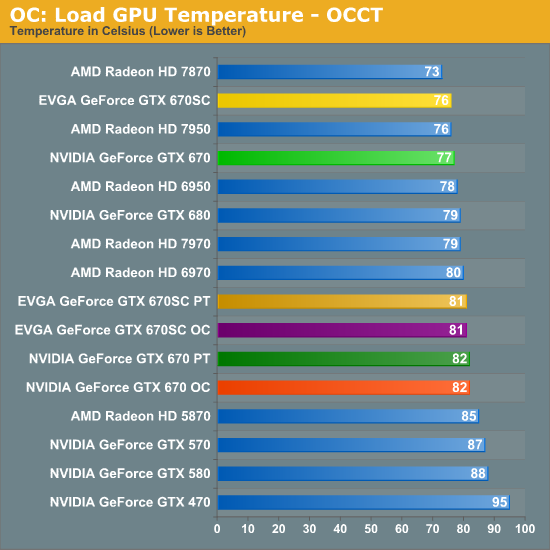
As to be expected, with an increase in power consumption comes an increase in load temperatures. However the fact that we’re only able to increase power consumption by about 30W means the temperature rise is limited to 4-5C, pushing temperatures into the low 80s. This does end up being warmer than the equivalent GTX 680 however due to the 680’s superior heatsink.
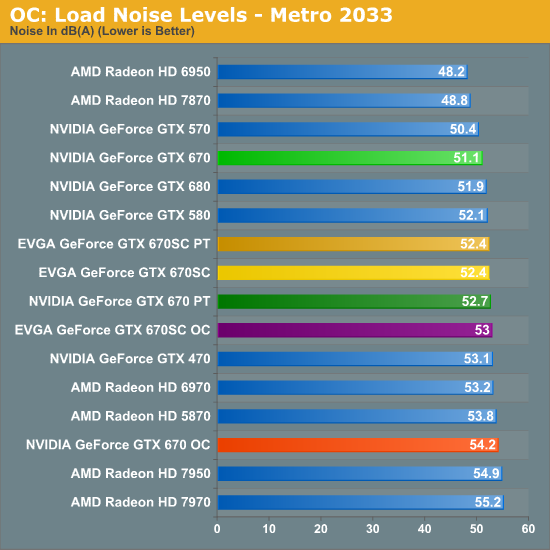

Finally, when it comes to noise we’re also seeing the expected increase, but again it’s rather small. Under Metro the amount of noise from the reference GTX 670 rises by under 3dB when pushing the power target higher on its own, while it rises 3dB when adding in our full overclock. Again the smaller cooler means that the GTX 670’s fan has to work harder here, which means our gaming performance may be able to reach the GTX 680, but our noise is going to slightly exceed it. As a point of reference, in the process we’ll also exceed the GTX 580’s noise levels under Metro. Still, in both OCCT and Metro none of our GTX 670 cards exceed the Radeon HD 7900 series, which means we've managed to increase our performance relative to those cards without breaching the level of noise they generate in the first place.










414 Comments
View All Comments
Spunjji - Friday, May 11, 2012 - link
Thank you for being a voice of sanity in an otherwise brutally argumentative and deeply sad comments section. +1 to you.CeriseCogburn - Friday, May 11, 2012 - link
"Voice of sanity" your amd fanboy friend, got the 43% larger amd wafer die size "cost drop not a problem" a bit overlooked, not to mention the 3 added free games additional cost.Is it a voice of reason to claim the largest base cost of the card at 43% greater is no problem since the "dies" are "about the same size" ?
ROFL... tsk tsk.
SlyNine - Saturday, May 12, 2012 - link
Its 43% greater now.Also you seem to forget the 7970 wins in 5 out of 10 of Anandtechs benchmarks.
Since you're going to argue this with me I'll put it out right now.
Crysis AMD
Metro AMD
Dirt 3 ( on the MOST Intensive test 5760x1200 min frames) Tied, but to me min frames is more important so I'd rather have AMD in that situation.
Now you can argue , But NVidia wins on the other res's But since this is the ONLY time it even gets below 60 this is the ONLY test that it really makes a difference.
ShoGun, AMD, big time, ya nvidia wins when FPS is over 100, but AMD wins by a lot when FPS is at a premium. With a driver fix I'm sure it will be a lot closer.
Batman, Basically a tie, yea Nvidia takes it but C'mon, 1 fps when it matters most. My guess is if they added 4x aa to the 3 screen mode AMD would take it.
Portal 2 Nvidia kills AMD, esp. in the high res, because that's where fps are low enough that the diff matters.
Battlefield 3 Nvidia kills amd again. and again when FPS matters.
SC2, Nvidia is faster. FPS is so high it doesn't matter But AMD is catching up fast and with the 5760res I wonder if AMD wouldn't' win. and by then FPS might actually matter.
Skyrim, same as SC2, AMD is catching up fast at the higher resolution, if it keeps going AMD might come out ahead where FPS is low enough that the difference matters.
Civ 5, tie. With the trend the Nvidia might be better at higher res here.
Portal 2 and BF3 are the to situation in Anands testing suit where Nvidia is MUCH better.
But other than that FPS either doesn't matter or AMD is winning when FPS is low enough that the difference matters.
As far as future games, we have NO idea what card might be better, but AMD does seem to have more raw power, and has more ram.
In compute AMD won 2 , loses one by like 7% and then actually loses one by a lot. Of course it doesn't have a cuda score so how to you count that as a loss, that's stupid.
CeriseCogburn - Sunday, May 13, 2012 - link
You make excuses across the board for the amd card, and nVidia's card is a smoother experience anyway if you want to glom onto min frames - and we haven't even used things like adaptive v-sync (better min frame rates for nVidia), nor did you figure in the enormous drivers difference.It's just such a huge gap when everything is considered it's beyond ridiculous to go for the amd card, as this amd favoring reviewer even admits.
Have your favorite brand, but you've got stretch and spin to justify it.
Galidou - Sunday, May 13, 2012 - link
I could just really stop answering you if that wasn't for the fact you're being so much disrespectful. I have a little problem with people lacking of respect, I have to let them know they are, even more when they do not think they are lacking respect...CeriseCogburn - Sunday, May 13, 2012 - link
You have never answered anything late comer troll Galidou, you're a pure 100% trolling personal attacker right now fella in all your posts so far. You have said absolutely nothing, so it is clear you should have never posted.Galidou - Monday, May 14, 2012 - link
I'm not attacking your person, just the way you throw your arguments at people calling them names like they are pure ignorant worthless living zombies... it just feels that way...Gastec - Tuesday, November 13, 2012 - link
"You make excuses across the board for the amd card, and nVidia's card is a smoother experience[..] - and we haven't even used things like..."We? WE?? YOU are from NVIDIA???? And you post here and admit it? I think you can get fired for doing this.
Or maybe you are not from nVidia but because you use a nVidia card you, for some very disturbing reason, feel like you are part of the company?
CeriseCogburn - Friday, May 11, 2012 - link
Okay, first of all substantial competition is the GTX590 and the 6990, that both still beat the overpriced amd lost 3 and only won 2 compute benchmarks in that 2.5+ month evil amd price scalping period before the massive smack down the nVidia 680 delivered.Now nVidia made a third move, the 670, not the initial move as you spoke about it, and this third move is another massive smackdown on the already smacked down by the 680 failing and utterly depleted value 7970 has to endure.
Nice try pretending the 1st smack down just occurred, but once again, what else to expect from an amd fanboy, and also clearly why another amd fanboy immediately thanked you a perfectly leveled headed post. LOL
Now onto your other ridiculous spew, based on facts not twisted perceptions.
You note the die sizes of the competing products, and conclude by stupid first look there is no reason amd cannot drop it's price (again) - you avoid the again, twice - (once for $$$(yes 3 figures), twice for 3 games added, now a 3rd time coming ) - but whatever, let's take your die size non chalant info and do our little math amd fanboys now desperately want to avoid.
300mm sq. nVidia vs 365mm sq Amd - doesn't look so bad does it ?
Unfortunately, the Amd die is well over 40% LARGER :)
Sorry about that amd fanboy brainfart .... you forgot to multiply for AREA, hence size/cost of the wafer....
300x300 vs 365x365
90,000 nVidia wafer area vs 133,225 huge 43% + more amd wafer cost.
So let's get this straight - do you still not really see a problem ?
yankeeDDL > " AMD will need to drop the prices and I see really no reason why they couldn't, as they have just a marginally larger die size (300mm2 vs 365mm2) on the same fab/technology. "
So 43% plus more base cost, no problem going a hundred bucks + games costs less... ?
R O F L
Thank you, as the amd fanboy said, for being such a clear thinking person with a calm and fair mind... (rolls eyes)
SlyNine - Saturday, May 12, 2012 - link
Its hard to say the 680 was a smack down when most people couldn't even get the card..You seem to be angered by the 7970. I agree that it was not a good deal. But its not a bad card either.